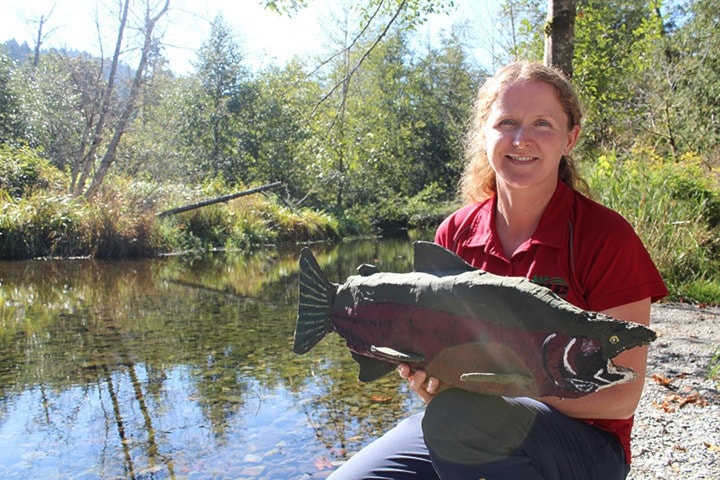A call comes over all salmon. An instinctual trigger they cannot ignore, leading them back to the place of their birth and, soon, of their death.
“They’ve been spending their life out in the ocean for three to four years, sometimes five, growing to be big adult salmon, defeating all the odds against them,” naturalist and manager of the Goldstream Nature House Tracey Bleackley explains. “Once that trigger has gone off they stop eating and they’re just swimming. They’re just heading here.”
Goldstream River is one of the last on the Vancouver Island coast to have its salmon run, primarily because of its southern location. For tourists and residents alike, however, it’s one of the most accessible and well known spots to see this circle of nature in action, drawing thousands of people to its banks.
After the journey south, achieved through scent, sight and a natural ability to find magnetic north, the salmon begin to make their way up the river when the temperature drops, the rain increases and leafs start dropping from the trees, releasing tannins into the water, the scent from which is another sign for the salmon to start swimming.
The females begin to swim against the current of the river as they search for the exact spot they were born. They can get within a metre of their own birthplace, using scent to pinpoint the location.
They being to dig holes to lay eggs in as the males begin to fight one another for fertilization rights.
“There are probably one female for every four male,” Bleackley said. “So there’s a lot of fighting.”
Fertilization happens at night. The female sinks into her nest, about one foot deep now, and leaves her eggs, at which point the dominant male has 15 seconds to fertilize them before the eggs are ruined.
It’s this entire spectacle which causes the parking lot of Goldstream Park to spill over to the sides of the Trans-Canada Highway every autumn.
While Bleackley loves that so many people come to the park to see the salmon, she also feels protective of her finned friends and does her best to make sure people know not to interfere.
Bleackley said she gets emotionally involved in the salmons’ plight every year.
“It’s the ups and downs. You love to have the salmon here but it also brings in a lot of people, so it means being a voice for the salmon too,” Bleackley said. “Not only are we educating people about the conservation and how amazing this natural phenomenon is right outside our back door, we’re also educating them about the proper etiquette on the river.”
Once the eggs are hatched the salmon’s purpose in life has come to an end and, with it, their life. Both the male and female fish, having laid and fertilized all the eggs they can, die.
“That part of the story is a little sad when people first learn about it,” Bleackley said. “But it’s pretty crucial as well.”
It’s far from the end, though. What park staff refer to as “the clean up crew” begins its work. Multiple species of birds and mammals, including hundred of eagles and some bears and wolves, make their way to the river to feast on the dead fish.
The rotting carcasses, sometimes dragged miles inland, also go on to fertilize the surrounding forest. Nutrients from the open ocean can be found in Goldstream Park trees from this process.
“Everything that exists around a salmon run is because of salmon,” Bleackley said. “Everything in the park is connected to salmon.”
Long after the scavengers have left, as the sun moves closer to our part of the world and the waters of Goldstream River begin to warm up in the early days of spring, the labours of the prior fall begin to pay off. The eggs begin to hatch, first into alevin, and then into fry, thousands of them, wiggling their way out of the gravel to begin their trip to the open ocean, ready to face a dangerous life in the hopes of starting the entire process over again.
Out of every 4,000 salmon eggs hatched, about the maximum a single female salmon can lay, four will make it back to the river to procreate.
Etiquette
The salmon are not used to the confined space of the river, having come from the open ocean, and are startled easily. Even a leaf falling off a tree can scare a salmon the point where it has a heart attack and dies.
Visitors are asked not to wear bright colours, to leave umbrellas at home, to not throw anything into or across the river and to keep dogs well away.
Visiting
The best time to see the spawning is mid to late october, when the salmon begin their journey up the river. The exact timeframe depends on the weather. After the run, when all the mature salmon have died, is also an interesting, if not fragrant, time to visit.
